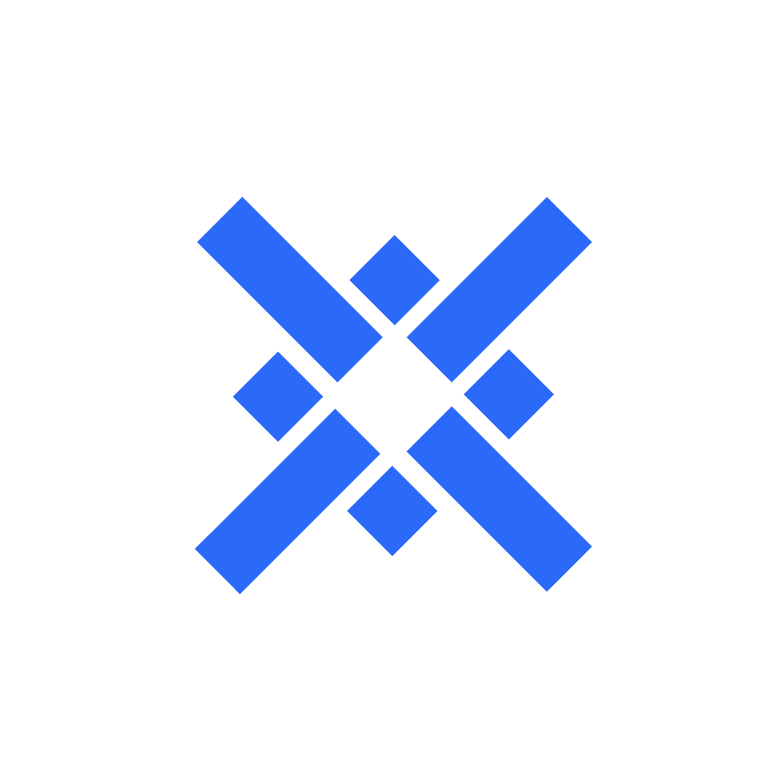Environment drives Rollup changes
Layer 1 expansion is imminent
As the number of Ethereum users continues to increase, the network is becoming increasingly busy, especially when launching new activities, gas fees often rise sharply. At the same time, as the price of $ETH tokens continues to rise, high fees block the possibility of small transactions. Therefore, improving storage efficiency, transaction throughput and reducing transaction latency are very important for the development of Ethereum.

Figure 1 Ethereum gas fee changes
Traditional Layer 1 expansion solutions generally include On-chain and Off-chain. On-chain refers to updating and optimizing Layer 1 by changing the consensus mechanism, implementing sharding, and expanding the block size; Off-chain refers to off-chain expansion, which mainly includes side chain and Layer 2 solutions. The biggest difference between side chain and Layer 2 is that the side chain relies on its own security protocol, while Layer 2 relies on the main network security protocol. Therefore, from a security perspective, Layer 2 is often superior.
In the past development, the implementation logic of Layer 2 is to process information offline and transmit the results to the chain, which not only improves the computational efficiency of transactions, but also gives full play to the high security performance of the ETH main network. The current mainstream implementation solutions of Layer 2 include: Channel, Plasma and Rollup. Because Rollup is essentially a further extension of the Plasma solution, with higher security, state validity and data verification capabilities, Rollup has become the basic direction of future Layer 2 development.
Which Rollup is better?
There are two major branches in Rollup, one is Optimistic-Rollup, and the other is ZK-Rollup. In Optimistic-Rollup, it is assumed that the transaction results submitted to the main chain are optimistic. Under this assumption, there is no need to verify each transaction immediately, allowing transactions to be submitted and processed quickly; and a challenge period of about one week is set, during which other validators can raise questions and submit corresponding evidence. If successful, the transaction will be rolled back and the wrong party will be punished. ZK Rollup uses zero-knowledge proof to immediately verify the correctness of the transaction and ensure that the transaction is almost 100% fraud-free. Overall, ZK-Rollup provides higher security than Optimistic-Rollup, and there is no delayed transaction confirmation during the challenge period. It has better application prospects. For this reason, Vitalik has repeatedly stated publicly that ZK-Rollup is the main line of future Layer 2 development.
However, since the technical implementation difficulty of ZK Rollup is much higher than that of Optimistic-Rollup, the mainstream market of Rollup technology is still occupied by Optimistic-Rollup.
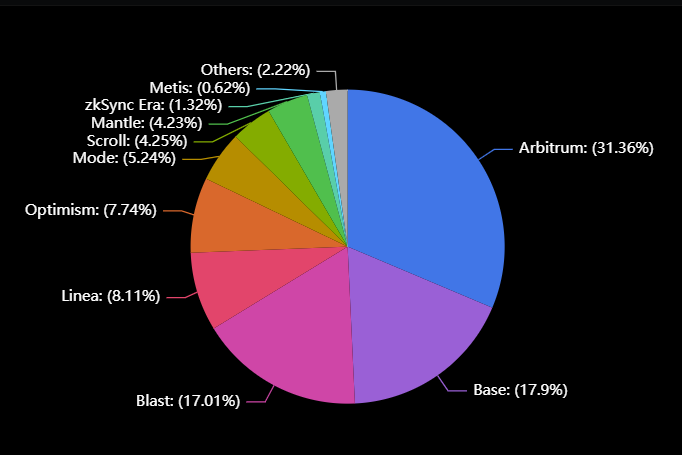
Figure 2 Rollup market TVL share distribution
Among them, Arbitrum is the current leader in Optimistic-Rollup, accounting for 31.36% of the TVL share, while zkSync Era only accounts for 1.32% of the TVL share. Because of this, how to shape a standardized ZK-Rollup solution and gradually expand the application market of ZK-Rollup has become an important issue? The overall solution that Lumoz can provide may become the key to breaking the deadlock.
Lumoz's strong background
Lumoz is a comprehensive ZK platform
Lumoz network is a globally distributed modular computing network. Combined with the DePIN network, it creates a powerful, secure, and flexible computing platform to provide computing power support for ZK-Rollup, ZK ML, ZKP, etc. At the same time, Lumoz focuses on the construction of ZK-RaaS, aiming to provide a complete set of ZK Rollup deployment and implementation plans to solve the current ZK-Rollup solutions such as incompatibility, centralized computing power, and concentrated risks.
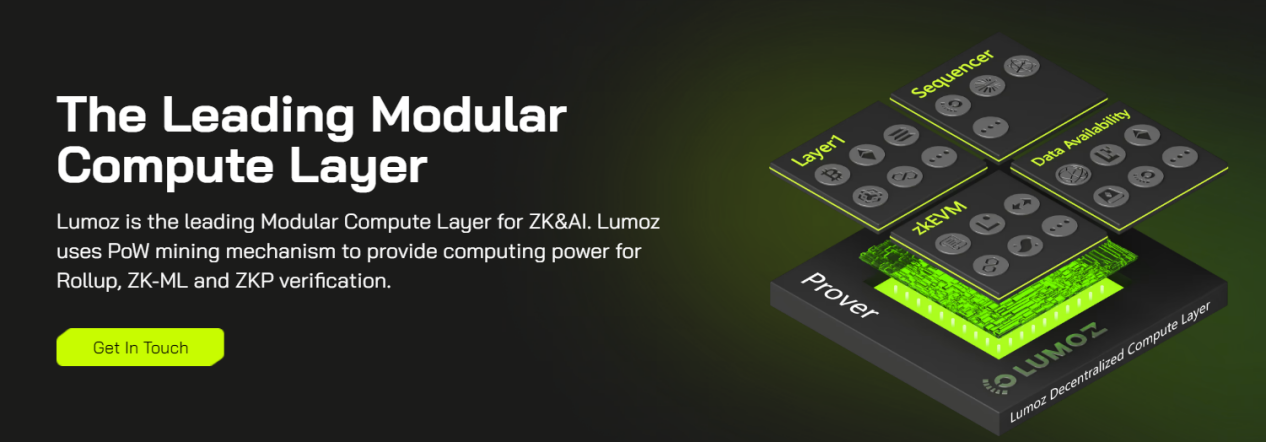
Figure 3 ZK Rollup promotional image
Deeply engaged in ZK field for many years
Unlike the large number of concept projects in the Web3 field, Lumoz has been deeply involved in the ZK field for many years. Its founder Nanfeng has served as an executive in many top technology companies and investment companies. He has rich technical knowledge and excellent blockchain project management capabilities. It is this cutting-edge thinking that has led him to lead the team to explore and research the ZK field since 2018.
Project establishment: In March 2022, Opside was established in Hong Kong, China. It is committed to becoming a blockchain expansion infrastructure provider and focuses on ZK-RaaS, helping developers create customized zkEVM chains through “one-click deployment”.
Seed round financing: In April 2023, Opside completed a US$4 million seed round of financing. The funds will be used to accelerate project development, expand team size and operations, and meet growing market demand.
Rename and rebrand: In October 2023, Opside was officially renamed Lumoz. The reason for the name change was to avoid confusion with Optimistic Rollup and to better reflect its focus on ZK technology. The new name Lumoz comes from the Latin word "Lumos", which means light and symbolizes the future development prospects of ZK technology.
Pre-Series A round of financing: In March 2024, Lumoz completed a US$6 million Pre-Series A round of financing, led by Hashkey Capital and OKX Venture, with a valuation of up to US$120 million.
Strategic Financing: In May 2024, Lumoz completed a strategic round of financing, with participation from IDG Blockchain, Blockchain Coinvestors, Gate Ventures, Summer Capital, EVG, 7 upDAO, Sweep Ventures, etc., with a valuation of up to US$300 million.
Node sale: Whitelist node pre-sale will start in June 2024, attracting a large number of investors to participate.
OKX Launchpad: Node public sale will start in July 2024, and Launchpad event will be jointly held with OKX.
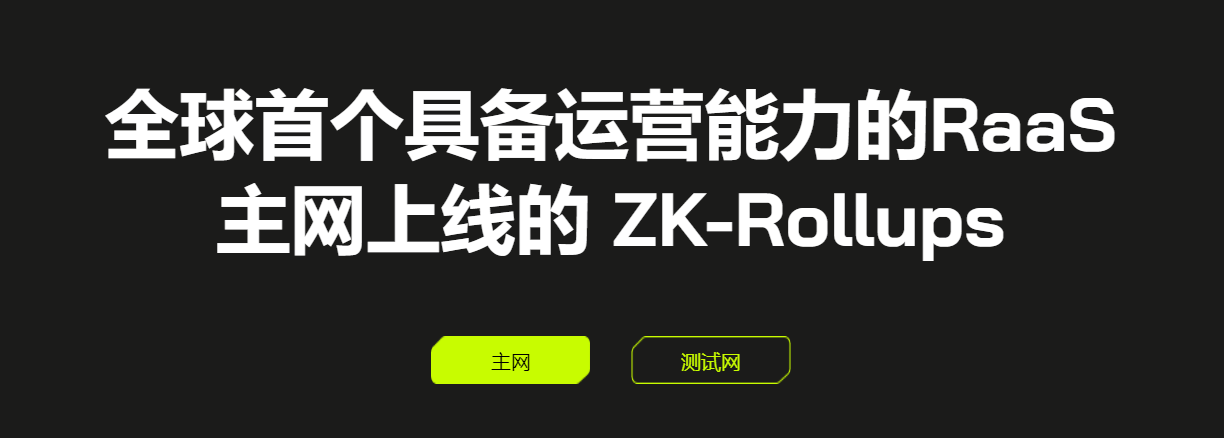
Figure 4 ZK Rollup promotional image
In addition to such a high value estimate, Lumoz has also delivered a perfect answer in actual action. Lumoz launched the testnet in May 2023, and has 28,403 POW nodes, 16 Rollups being allowed, 470,000 ZKP submissions, and 20 million transactions to date;
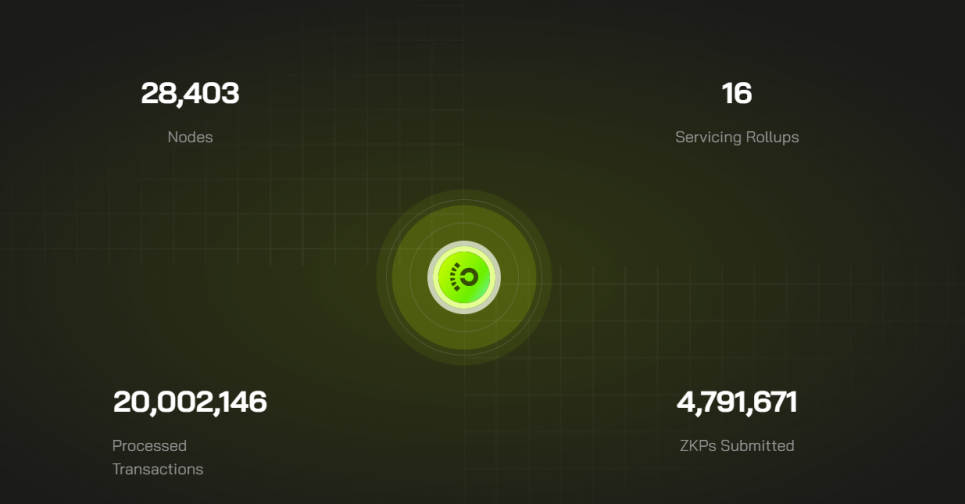
Figure 5 Lumoz operation status
On the technical side, Lumoz launched ZK-Rollup Launchbase, added support for ETH, BSC, and Polygon testnets, and provided various modular components such as data availability (DA) and shared sorters. It also implemented a number of breakthrough inventions, including ZKP Two-step Argrithum, NCRC, zkVerifier node verification mechanism, and Lumoz RaaS Launchbase high compatibility technology stack. At the same time, Merlin chain's ZK calculations in ZKFair are all supported by Lumoz, and the technology has been initially implemented.
Unifying ZK’s Technical Solution
Lumoz provides a modular computing layer
Modular Rollup provides a new approach to solving the blockchain impossible triangle problem. Rollup generally decomposes the blockchain system into different modules to achieve a hierarchical structure, achieve more efficient transaction processing and data management, and thus balance the issues of decentralization, security, and scalability to a certain extent. Conventional Rollup generally includes a settlement layer, an execution layer, a consensus layer, and a data availability layer.
Settlement layer: Update the status of blockchain assets on Layer 1 to ensure asset security.
Execution layer: processes transactions on Rollup, records and updates transaction status.
Consensus layer: Reach consensus on transactions to ensure transaction security.
Data availability layer: records and aggregates all transaction data to ensure data traceability.
In addition to the four layers of conventional Rollup, Lumoz also includes a core module Prover Layer, which provides censorship-resistant distributed computing, implements ZKP, and guarantees the authenticity and validity of transaction status.
ZK computing resources + EigenLayer re-staking dual narrative
Lumoz integrates powerful ZK computing resources with the EigenLayer re-staking mechanism through Lumoz Oracle, zkProver, zkVerifier and Lumoz Chain, allowing users to re-stake already staked tokens into EigenLayer. Lumoz will improve the security of its active verification service (AVS); at the same time, the staked tokens will serve as node guarantees to prevent malicious behavior of nodes.
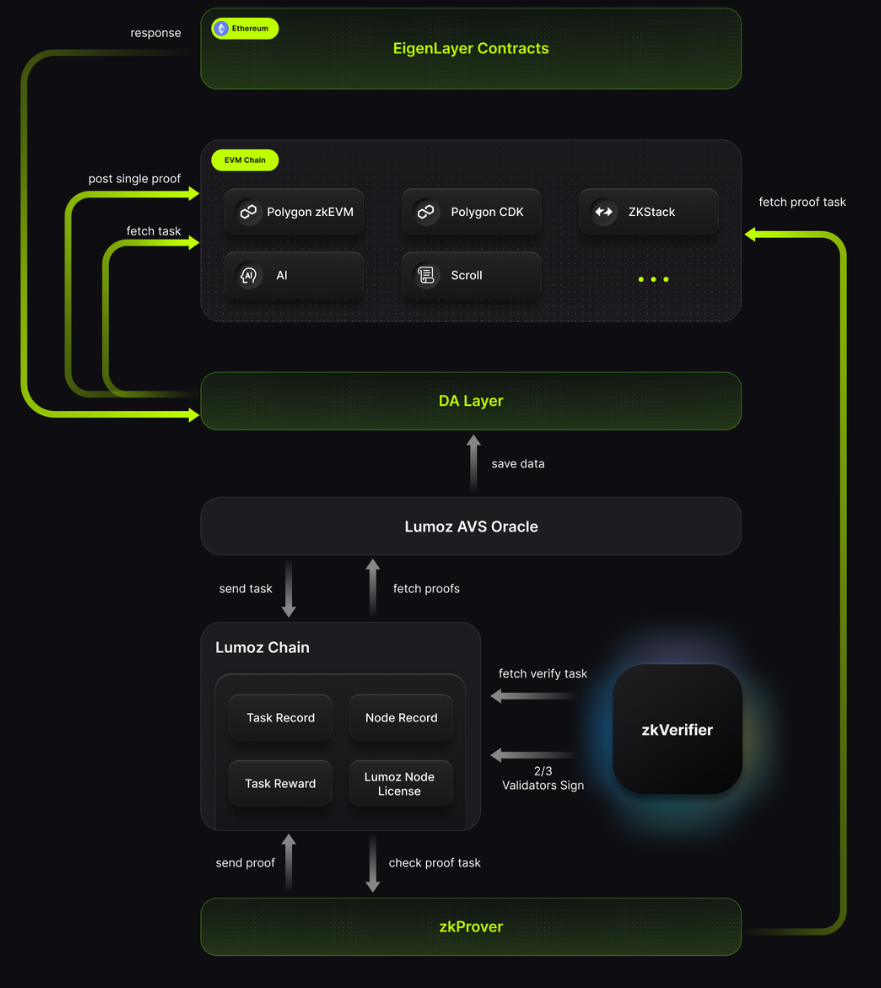
Figure 6 EigenLayer re-staking process
Staking and re-staking: Users stake tokens on blockchain networks such as Ethereum, and these tokens are re-staken to Lumoz’s AVS through EigenLayer’s re-stake mechanism, increasing the security of the verification service.
Data processing and storage: Lumoz AVS Oracle retrieves and stores data from EVM-compatible chains, ensuring data availability and integrity. This data provides computational input for zkProver and provides zkVerifier with the information required for verification.
Task allocation and execution: Lumoz Chain is responsible for task scheduling and assigns computing tasks to zkProver nodes; zkProver nodes execute computing tasks and generate ZKP.
Result verification and confirmation: The zkVerifier node verifies the proof generated by zkProver to ensure the correctness of the calculation results. After verification, Lumoz Chain records the results on the blockchain and incentivizes participating nodes through a reward mechanism.
This process allows multiple verification servers to share a set of tokens, thereby improving resource utilization and computing efficiency, which is extremely important for the generation of ZKPs with high computing requirements; through re-staking, Lumoz can better support a variety of EVM-compatible blockchain environments, such as Polygon EVM, Scroll, etc., increasing the scalability of the platform.
Optimize ZKP calculation and submission mechanism
Lumoz optimizes the ZKP calculation and submission mechanism, supports ZKP parallel calculation and sequential submission, decomposes ZKP into multiple subtasks, which can be calculated on different zkProver nodes and finally submitted in the correct order.
In addition, Lumoz proposed a novel recursive aggregation algorithm when processing ZKP, which can aggregate multiple ZKPs into a smaller ZKP. Through recursive methods, it reduces the size and complexity of ZKP and reduces the occupancy of blockchain storage and computing resources.
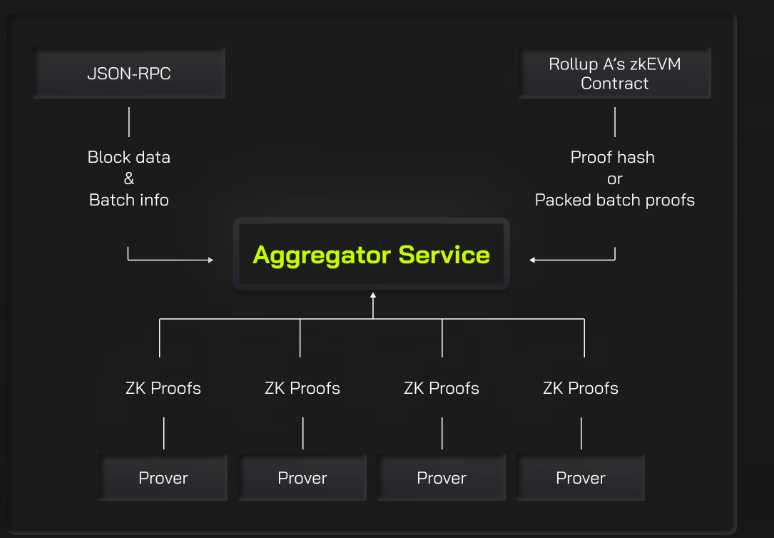
Figure 7 ZKP optimization solution
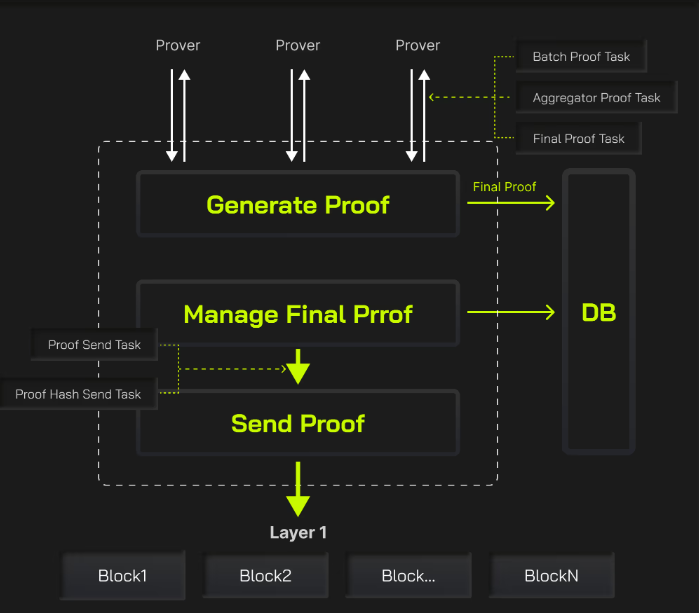
Figure 8: zkProver high-performance component Aggregator
Aggregator serves as the core manager in zkProver, ensuring efficient allocation of computing tasks and precise scheduling of verification.
The most compatible ZK-RaaS solution
Providing the ZK-Rollup solution with the lowest deployment difficulty and the strongest compatibility has been the goal of Lumoz since its inception. Today, ZK-RaaS Launch Base supports all mainstream zkEVM technologies, and developers can easily deploy and start ZK-Rollup with some simple operations.
Base layer selection: Lumoz supports multiple networks, such as ETH, Polygon, Lumoz chain, etc.
zkEVM configuration: Select the zkEVM type according to actual needs, such as Polygon zkEVM, zkSync, Scroll, and StarkNet.
Gas Token and Data Availability Layer: Select gas token and corresponding data availability layer according to project requirements to ensure transaction security.
Modular customization: Lumoz provides a series of functional modules that can be directly integrated into ZK-Rollup according to needs.
Specifically, Lumoz's ZK-RaaS platform supports multiple architectural models simultaneously.
Modular Compute Layer: The modular computing layer provided by Lumoz can support various Layer 2 solutions, including architectures such as Op Stack + ZK Fraud Proof. This modular approach allows developers to choose different base layers, zkEVM types, data availability layers, and sorters as needed.
Native Cross-Rollup Communication: Lumoz also supports native cross-Rollup communication between different ZK-Rollups on the same base chain. This communication mechanism enables the address on one Rollup to interact directly with the contract on another Rollup, thereby enhancing the interoperability between applications.
Customizable Infrastructure Services: Lumoz provides a variety of infrastructure services, such as bridge interfaces, customized zkEVM types, block browsers, decentralized exchanges, decentralized identity systems, wallet infrastructure, etc. These services allow developers to customize various aspects of ZK-Rollup according to their project needs.
Thanks to Lumoz’s contribution, the deployment of ZK-Rollup will make the leap from difficult to easy, which may mean the beginning of the ZKP application trend.
Node pre-sale seizes the opportunity
zkVerifier License for sale
Lumoz implements the zkVerifier certificate mechanism to provide 100,000 licenses, which are divided into 10 different price stages. Only users with licenses are allowed to run zkVerifier nodes, and can delegate certificates to other nodes for operation to obtain benefits. The zkVerifier sale activity is mainly divided into three stages, including the whitelist stage (June 17 15: 00, UTC+ 8), the whitelist sales stage (June 25 15: 00, UTC+ 8) and the public sale stage (July 3 15: 00, UTC+ 8). Users who obtain the whitelist can enjoy a 10% purchase discount during the whitelist sales stage, and secondly, they can get a 10% rebate by inviting others to purchase.
Different from the traditional node license sales, Lumoz provides users with Lumoz points distribution. From June 25 to August 4, 1 million Lumoz points will be distributed every day. The distribution of points will refer to the staked license weight. Participating teams can increase the overall weight. At the same time, the earlier you purchase the license for staking, the greater the possibility of obtaining income. After TGE, users holding Lumoz points can share 25% of the tokens.
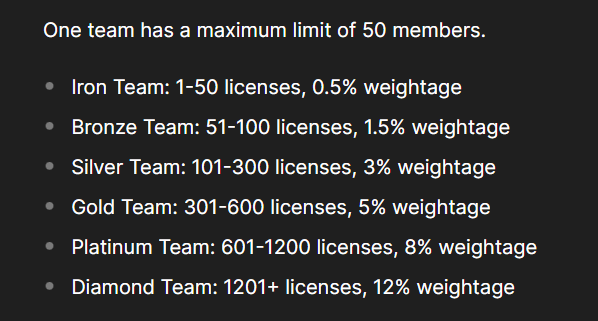
Figure 9 Team Weighting for License
Lumoz provides a refund mechanism for unsold licenses, allowing users to get 80% of the purchase funds back within a 6-month window after TGE, greatly avoiding risks.
Obviously, buying a zkVerifier License is a very good business, which can earn high returns with low risk. That is why the license purchase activity is extremely fierce. As of the time of writing, 64,708 licenses have been sold, reaching the 7th stage, with an FDV of an astonishing $79,131,216.

Figure 10 License sales data
OKX Launchpad Node Sales
OKX and Lumoz jointly launched the zkVerifier Launchpad event (July 11 18:00 to July 18 00:00 (UTC+ 8)), which includes 200 Tier 3 nodes (265 USDT) and 800 Tier 4 nodes (304 USDT). During the event, you can purchase nodes at a minimum of 60% off by completing the tasks on the OKX website. Currently, the number of participants has reached 36,352.
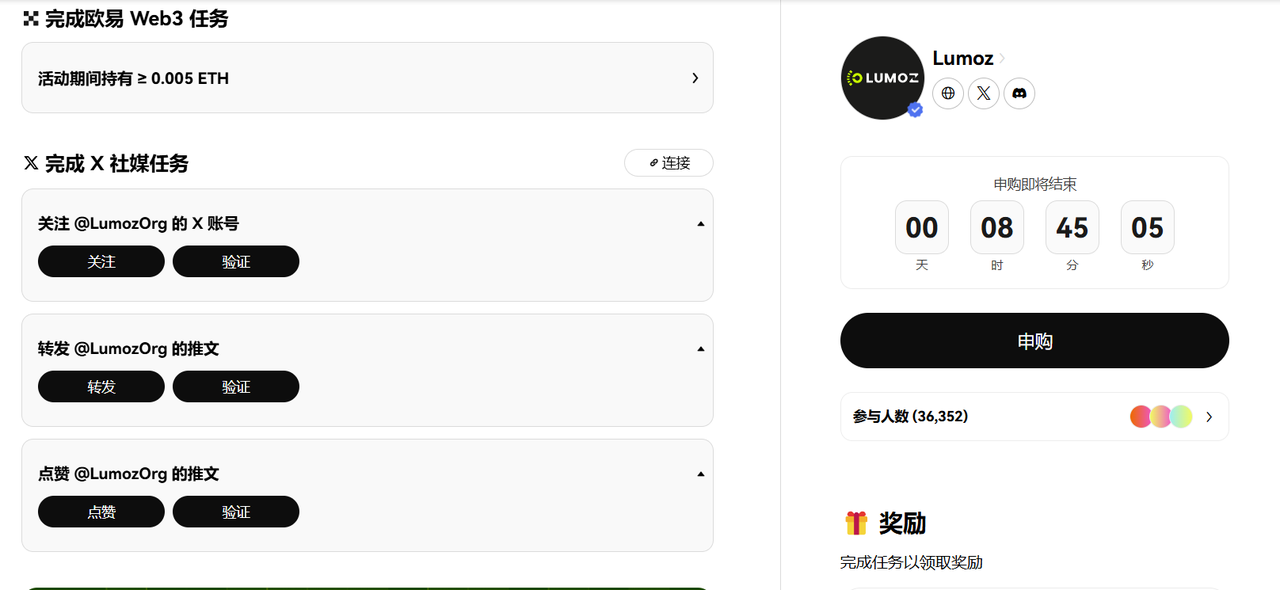
Figure 11 OKX launchpad activities
Token Model
The Lumoz token economic model is a typical dual-token governance model, providing two tokens, MOZ and esMOZ.
MOZ is the native token of the mainnet and exists as the core asset of the mainnet.
MOZ can be used as gas fees for Lumoz mainnet transactions.
The ZKP services and AI computing power services provided by Lumoz need to be paid through MOZ.
MOZ can be exchanged for esMOZ at a ratio of 1:1.
esMOZ is used as an ecosystem governance token for mainnet ecosystem construction and maintenance.
Lumoz provides esMOZ as a reward to incentivize mainnet computing power providers and node operators.
Users use esMOZ to delegate the network and complete decentralized governance.
It is worth mentioning that the ratio of esMOZ to MOZ changes over time. During the 10-day redemption period, the redemption rate is 100%; during the 7-day redemption period, the redemption rate is 70%; during the 3-day redemption period, the redemption rate is 50%; during the 1-day redemption period, the redemption rate is 10%. This redemption mechanism can reduce the market pressure of miners' tokens, and effectively prevent hackers from redeeming a large amount of esMOZ after an attack, which affects the market, and safeguard the rights and interests of MOZ buyers.
Why we are optimistic about Lumoz
As early as 2022, when Vitalik proposed that ZK-Rollup would be the best solution for the future of Layer 2 Rollup, the booming development of ZK-Rollup was already destined.
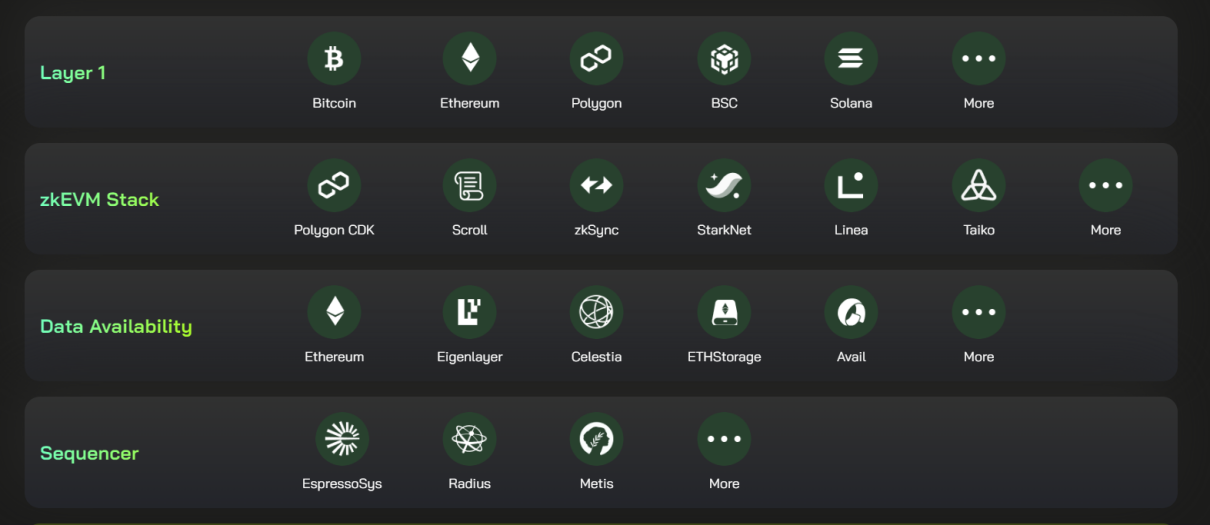
Figure 12 Lumoz structure
The emergence of Lumoz will integrate the past situation of ZK-Rollup working independently, and while optimizing the construction of ZK-Rollup, create a complete set of simple deployment processes for ZK-Rollup.
The Rollup revolution is imminent, and the emergence of Lumoz meets the urgent need to integrate ZK-Rollup and drive industry updates.
Lumoz provides a modular computing layer, combined with EigenLayer in the staking concept, to upgrade the mainnet security and scalability.
Lumoz optimizes the ZKP process to fully utilize computing resources and improve computing efficiency.
Lumoz provides a complete set of ways to deploy ZK-Rollup, which may usher in a new round of ZK-Rollup projects.
In general, the emergence of Lumoz will solve the problems of difficult ZK-Rollup deployment in the past, high ZKP computing resource requirements resulting in computing centralization, and other problems, taking the most critical step towards the further development of ZK-Rollup in the future.


